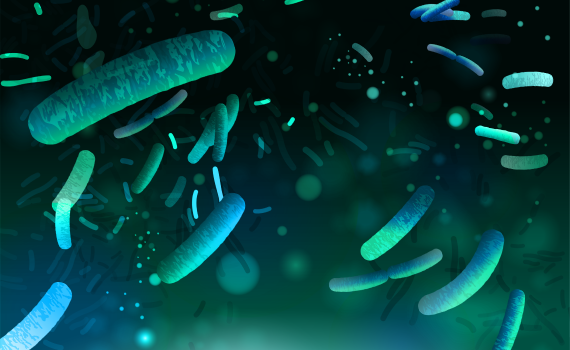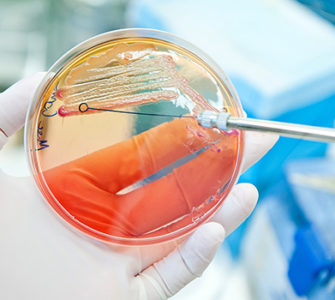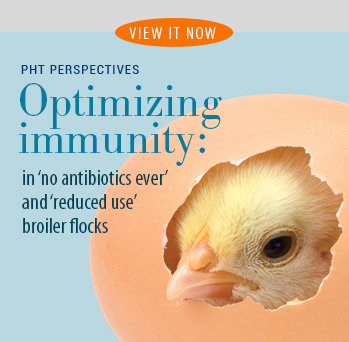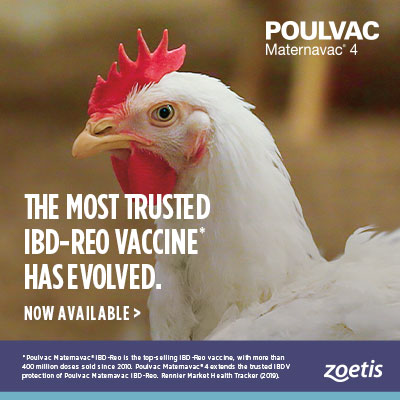Gut microbiota changes linked to E. coli vaccination may support gut health, broiler immune response
A recent study found that administering a live Escherichia coli vaccine by spray produced marked, consistent changes in the intestinal microbiota of broilers, which may account for gut health improvements observed in vaccinated flocks while indirectly supporting vaccine response.1
The research builds on previous work showing that the activation of mucosal immunity — a type of immunity that occurs at mucosal membranes of the intestines, respiratory system and urogenital tract — may be the main mode of action of the live, aroA-deleted E. coli vaccine used in the study (Poulvac® E. coli).2 With anecdotal evidence of improved intestinal health in broiler flocks following the spray administration of the vaccine, the researchers hypothesized that the intestine may be an important site for the vaccine’s functionality.
“Considering that live bacterial vaccines are able to target the intestine and that there is an interaction with its commensal microbiota, we hypothesized that vaccine protection resulted at least partially from an intestinal immune component,” said Eduardo C. Muniz, DVM, PhD, manager of poultry technical services and outcomes research at Zoetis Brazil and one of the study’s authors.
“We therefore tested the role of intestinal, respiratory and systemic immune and microbial components following administration of a live E. coli vaccine in broilers.”
Study design
The study, which was sponsored by Zoetis and took place in Brazil, was conducted in 160, 1-day-old Cobb broilers that were divided in two groups. One group was spray-vaccinated with Poulvac E. coli on arrival at 1 day of age, while the other group served as negative control.
Throughout the study, the researchers evaluated intestinal microbial composition and various indicators of immune response. To characterize the caecal microbiota, they collected samples on days 3, 14 and 25 and assessed them with next-generation sequencing.
Cytokine measurements were based on samples taken on days 1, 3 and 14. To determine the peripheral immunotype of vaccinated birds, the researchers took blood samples on days 1, 3, 7, 14, 21 and 25. To explore the activation of CD4+ TCR Vβ1+ cells, which play a key role in mucosal immunity, the researchers collected organs from the animals on days 3, 7 and 14 for spectratyping analysis.
Results
Results demonstrated marked alterations to the caecum microbiota of broilers within 3 days of vaccination, an effect that gradually waned over time. Notably, vaccination was associated with a concentration of microbiota into fewer genera and increased populations of bacteria known to directly affect immune response, such as Lactobacilli and Streptococci (Figures 1 and 2).
The vaccinated groups also had greater quantities of E. coli within 3 days of vaccination, as expected on account of the vaccine strain, but by 14 days of age, the vaccinated groups had lower field E. coli counts than the non-vaccinated groups.
Analysis of the peripheral immunophenotype confirmed that vaccination has a marked effect on CD4+ TCR Vβ1+ cells, as found in previous studies. These cells help B lymphocytes produce immunoglobulin-A (IgA) in the mucosae, and the number of these cells in blood is directly correlated to intestinal counts.
However, results show that following vaccination, clonal expansion of these cells occurred in the spleen but not the caecal tonsils, and anti-E. coli IgA was concentrated in the respiratory mucosae. Accordingly, IL-6 mRNA, which induces the formation of antibodies against E. coli antigens, was produced in the lungs.
Conclusions
Overall, the results indicate the relative importance of different mucosae on the mechanisms of action of Poulvac E. coli when administered by spray, the researchers concluded. Changes in TCR Vβ1+ lymphocyte activation and specific IgA production indicate that the gut-associated lymphoid tissue is not a predominant immune site following vaccination, they wrote, and immunity seems to arise at the respiratory-associated lymphoid sites or at other secondary lymphoid tissues, such as the spleen.
However, they added, the consistent changes to the intestinal microbiota of vaccinated birds — notably the increase in beneficial bacteria such as Lactobacilli — may account for the reported intestinal health improvements following immunization. These improvements may in turn indirectly affect the outcomes of E. coli vaccination in poultry, they noted.
“These changes in the microbiota constituted the most important consequences of vaccination to the intestinal health in the present trial,” they wrote.
1 Beirão B, et al. Effects of aroA deleted E. coli vaccine on intestinal microbiota and mucosal immunity. Comp Immunol Microbiol Infect Dis. 2021 April;75:101612.
2 Filho TF, et al. Effect of Spray Escherichia coli Vaccine on the Immunity of Poultry. Avian Dis. 2013;57:671-676.
All trademarks are the property of Zoetis Services LLC or a related company or a licensor unless otherwise noted.
DISCOVERIES, Issue 13
Discoveries is a series of research news reports written by the editors of Poultry Health Today on behalf of the Global Poultry Business of Zoetis.
©2021 Zoetis Services LLC. All rights reserved. July 2021 MM-14040
Posted on July 22, 2021



















